| Reviews & Columns |
|
Reviews DVD TV on DVD Blu-ray 4K UHD International DVDs In Theaters Reviews by Studio Video Games Features Collector Series DVDs Easter Egg Database Interviews DVD Talk Radio Feature Articles Columns Anime Talk DVD Savant Horror DVDs The M.O.D. Squad Art House HD Talk Silent DVD
|
DVD Talk Forum |
|
|
| Resources |
|
DVD Price Search Customer Service #'s RCE Info Links |
|
Columns
|
|
|
Sam Peckinpah's Legendary Westerns Collection
The last two years have been kind to Sam Peckinpah, and I wonder how he'd feel about the special edition treatment that his films have received on DVD lately if he hadn't died far too young in a paranoid, drug addled stupor. By the time he passed his life was pretty much completely out of his control and his career in the gutter but over time his movies have started to finally garner the following and the critical acclaim that eluded much of his work during his day. It's ironic and sad that it happened that way, but better late than never.
Complimenting their recent two disc special edition of The Getaway and other recent Peckinpah DVDs such as Anchor Bay's two disc The Osterman Weekend release and MGM's Bring Me The Head Of Alfredo Garcia, Warner Brothers manages to fix a previously botched release (The Wild Bunch) and bring three new to DVD titles (Ride The High Country, The Ballad Of Cable Hogue, and two versions of Pat Garrett And Billy The Kid) to the market in one fine boxed set (though note that the titles are also all available individually should you have something against boxes).
Ride The High Country (1962):
After Peckinpah's feature film debut, The Deadly Companions (which really needs a decent widescreen DVD release), was more or less taken from him in its final stages, he was lucky enough to get a second shot with 1962's Ride The High Country. While the film doesn't hit on all of the notes that his better known work manages to pick at, make no mistake, this is a Peckinpah movie through and through, even if it doesn't wreak of blood and whiskey.
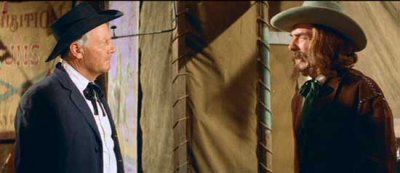
Steve Judd (Randolph McCrea) is a U.S. Marshal getting on in years. When he's tasked with escorting a large gold shipment from a mine camp through bandit infested territory to ensure that it gets back to the bank safe and sound, he hires his old friend Gil Westrum (Randolph Scott) and a young buck named Heck Longtree (Ron Starr) to help him out should he run into trouble that he can't handle on his own.
What the well-intentioned Judd doesn't realize is that his old buddy Gil has changed a bit over the years. He and Heck are planning on stealing the gold for themselves and they don't care too much about whether Judd gets in the way or not. They're bound and determined to carry out their crime, even if it means shooting down a good man in cold blood. Along the way, Heck falls for the daughter of a manic preacher named Elsa Knudsen (Mariette Hartley), and things get complicated. Not only is she trying to get out from under her father's thumb but she's also trying to make it to the mine camp where she plans on running off with the man of her dreams, who may or may not be inbred. To make matters worse, her brother Joshua (R. G. Armstrong) has got a few screws loose.
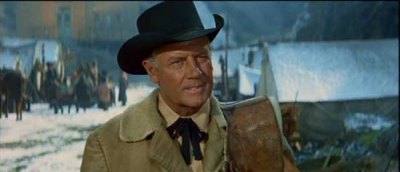
A classic adventure movie that, like a few of his films, deals with the aging west both in terms of frontier life and in terms of the characters that inhabit the tale, Ride The High Country doesn't get nearly the credit that it deserves. Yes, Peckinpah would later find himself and his filmic voice (he'd also lose it shortly after) and he's not quite at the top of his game here but he manages to pull some absolutely fantastic performances out of two classic American western stars and tell a good story in the process.
Despite the fact that individually they'd starred in scores of western films, Randolph Scott and Joel McCrea had never starred with one another in the same film before. They show instant respect and true affection for one another in the film, and while the characters do have their ups and downs, these two old pros deliver admirably a pair of sincerely fine performances. Mariette Hartley is as charming as she needs to be, a much more likeable female character than most of the women in Sam's movies, and it's completely understandable when Ron Starr's Heck starts to fall for her. She's pretty and charming and cute, a flower in the desert so to speak. Peckinpah regular Warren Oates (who will always hold a special place in many peoples' hearts as Benny from his later Bring Me The Head Of Alfredo Garcia) is excellent in a small supporting role as one of her fiance's brothers, and Edgar Buchanon as the drunken judge who presides over the wedding is also quite good.
Don't come to this one expecting slow motion gun play or poetic bloodshed, because you'll walk away disappointed but if Peckinpah's work speaks to you about loss, regret, and the sadness one experiences sometimes through aging and through life's circumstances, then you'll more than likely walk away from Ride The High Country an impressed viewer. It's a simple story, but a no less effective one that serves as a fitting good bye to Randolph Scott, who would never make another film after this one wrapped up.
The Wild Bunch (1969):
From the opening scene where a gang of rough and tough men take the patrons at a railroad depot hostage (punctuated by William Holden's most famous line, the wonderfully snarled 'If they move… kill'em!) to the grand gattling gun finale, The Wild Bunch stands as not only Sam Peckinpah's most polished and perfectly made film and not only one of the best American westerns ever made but one of the best movies ever made, period. Say what you will about Peckinpah, about his personality, his issues with women, his addiction problems or his relationships with studio execs and performers but when the man was on, he was on and he was never more on than in this film here, and the long standing influence that it continues to have even today goes a long way towards backing those rather lofty statements up.
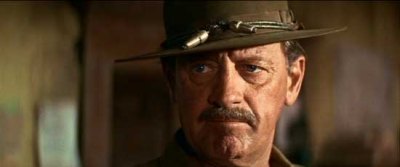
Pike Bishop (William Holden) leads a gang of outlaws made up of the two Gorch Brothers, Lyle (Warren Oates) and Tector (Ben Johnson), an older man named Freddie Sykes (Edmond O'Brien), a Mexican named Angel (Jaime Sanchez) and his partner in crime and all around good buddy, Dutch Engstrom (Ernest Borgnine). After leaving the train depot, they flee from the law to Mexico where they hope to take it easy for a while, but a law man named Deke Thornton (Robert Ryan) who has a past with a few members of the gang is hot on their trail and intends to bring them in dead or alive.
Once they make it across the border, the guys meet up with a rebel named General Mapache (Emilio Fernandez) who is struggling to defeat Pancho Villa. Mapache convinces the gang to steal him a large shipment of guns and ammunition off of an army train so that he can use them to defeat Pancho Villa, but there's something they don't trust about Mapache. One thing leads to another, a few double crosses are played out, and Deke Thornton moves closer and closer to the aging outlaws out to make one last score…
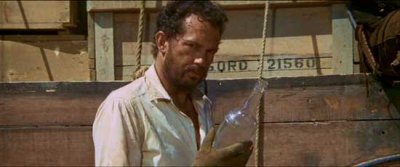
Saying anymore about the plot would be a grave injustice to the one or two people reading this who haven't seen this masterpiece. If you pay close attention you can tell from the foreshadowing where it's all going and how it's going to end, these men are in a way predestined to live life the way they do in this film, but getting there is half the fun.
Working with an excellent cast of seasoned actors, Peckinpah wrangles some fantastic performances out of his stars. William Holden and Ernest Borgnine have never been better and the knowing looks that they give each other at the finale say so much with so few words that it's quite a testament to their ability. Sure, not everything these guys were in was a masterpiece, but here they really shine. Of course, being surrounded by the likes of Warren Oates, Ben Johnson, Edmond O'Brien and Robert Ryan doesn't hurt matters at all, either.
The cinematography by Lucien Ballard, who would also work with Peckinpah on Junior Bonner and The Getaway, effectively captures the dirt and grit of the Mexican locales. You can feel the sweat on the brows of the men as they fight their way through the various obstacles that stand in their way and in terms of visual contrast, the spilt blood across the harsh desert landscapes makes for a strange and overtly bloody looking movie. The often talked about glorified violence of the film (Peckinpah reportedly used ten thousand squibs and fired off ninety thousand rounds during the production) might seem like an exercise in excess but let's face it, it's not pretty when someone gets shot and to sugar coat the impact of a shooting is to basically render the scene impotent. Adding to this, the editing does an amazing job of highlight certain hits and illustrating the choreography's intensity on film.
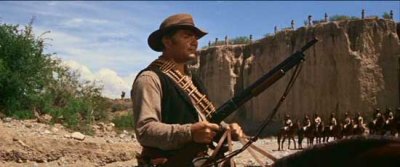
Despite the undeniable violence that stands out so much when thinking about the film, the story also focuses on some more sensitive issues, such as loyalty, aging, loneliness and regret. The central characters have never really known any other way and as such, they've lived the lives that outlaws lead, never settling down or leading a normal life and as their twilight years approach them, they obviously begin to ponder that a bit. Scenes such as when Pike and Dutch talk about their lives quietly to one another beside a picturesque campfire add real heart to the rough and tumble exterior of the film, which serves to make it a whole lot more than just another western shoot'em up.
Made after the miserable box office failure that was Major Dundee, Peckinpah's The Wild Bunch went on to find enduring popularity and was nominated for both the Best Screenplay and the Best Music Academy Awards. Despite the fact that the movie went grossly over budget and took far longer to complete than the studio execs had hoped for, the movie did give Peckinpah some much-needed clout in tinseltown. A truly epic story, a truly epic score, and some amazing performances make The Wild Bunch a damn near flawless film.
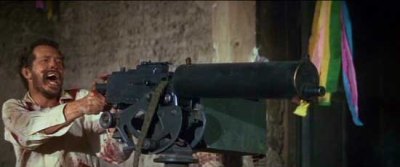
The Ballad Of Cable Hogue (1970):
It's interesting that The Ballad Of Cable Hogue was made directly after the savage The Wild Bunch as it's pretty far removed from the violence and nihilism of that film, even though it too deals with some of the same themes in a similar western setting.
Cable Hogue (Jason Robards) is left to die out in the harsh desert sun by his two backstabbing partners, Taggart (L.Q. Jones) and Bowen (Strother Martin). The two rats take off with his canteen and his horse and leave him there to fend for himself. Things don't look good for Cable, as he crawls around in the dirt babbling to God above and hoping for some sort of miracle to save his sorry skin, until his prayers are answered and he finds a fresh water spring.
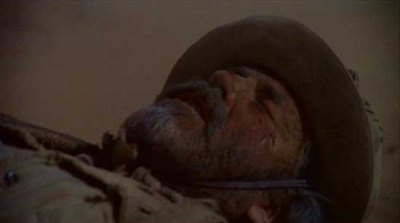
Being a rather sharp cookie with a good head for business, Hogue knows that this spring happens to be just off the wagon trail and that it's a pretty popular path for people to take on their travels. He gathers his wits and sets up a little rest stop where he starts selling water to road weary travelers and soon enough he's built himself a nice little house out there and shacked up with a prostitute named Hildy (Stella Stevens) from the next town over.
Hogue isn't just out to make a quick buck, however. He still wants revenge against Taggart and Bowen and he knows that sooner or later their paths will cross again. After all, he's setup the only shop on one of the most popular wagon trails in the area, and logic would dictate that eventually they'll find their way to his rest stop.
What separates The Ballad Of Cable Hogue from the bulk of 'Bloody' Sam's work is that at its heart, the film is essentially a romantic comedy. Yes, it's set in the last days of the old west just like The Wild Bunch and it deals with prostitutes and tough, grizzled cowboys and all the rough edges that type of life entails but there really is a very obvious sweet side to this movie that we don't really see in any of the director's other films. The relationship between Hogue and Hildy might be a tad unorthodox and the film makes it very clear that the first thing on Hogue's mind isn't Hildy's conversation tactics or her bright insight into world events but they do grow to really love one another despite their seedy origins as a couple.
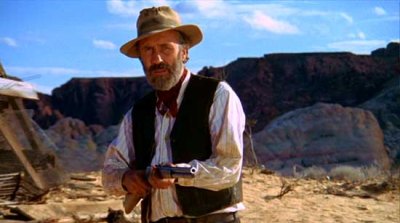
Things do tense up a fair bit towards the end of the movie when the revenge subplot comes closer to being resolved but even then, there are moments of genuine tenderness and comic relief scattered throughout. Hogue's interactions with a horny preacher man named Reverend Joshua Sloan (David Warner) is interesting as Hogue knows exactly what his game is. In a sense, these two womanizers are cut from the same cloth, and it's not the same cloth that you usually associate with a man of God either. Peckinpah regulars Slim Pickens, R. G. Armstrong and L. Q. Jones show up in the film in various capacities, and the theme of the old west getting even older and riding off into the twilight with the advent of the automobile lingering in the foreground make sure we know that we're still in Peckinpah country, even if we're in a kinder, gentler part of that land. The ending is interesting as, without wanting to spoil it, it does leave certain decisions as to the reality of the events we witness up to the viewer to decide. The movie doesn't spell everything out for us as simply as you might think and the argument could certainly be made that all of this is simply happening in Hogue's mind before he passes on. This adds some darkness to the movie that seems odd against the rather jovial atmosphere and border line slapstick comedy that we get in certain scenes, but that works in that it reminds us of the humanity of the lead character.
Despite plenty of production problems, the firing and hiring of certain crew members and some obvious flaws in the movie, The Ballad Of Cable Hogue remains an excellent film that demonstrates perfectly that there was more to Peckinpah than blood, guts and dope.
Pat Garrett And Billy The Kid (1973):
Pat Garrett (James Coburn) and Billy The Kid (Kris Kirstofferson) used to be great friends, but things have changed since those days. Garrett now wears a badge and Billy refuses to give up his outlaw ways. This obviously puts them at odds, and soon enough Sheriff Garrett is tasked with bringing Billy in on murder charges. The gavel comes down and Billy is sentenced to death by hanging seventy-two hours later, but being Billy The Kid, he manages to get himself a shotgun and kill his way out of the holding cell and make a break for it into the desert.
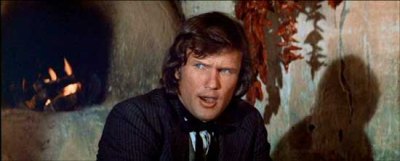
With Billy on the run, Garrett has no choice but to go after him and once he does, the chase is on. The rest of the film is, more or less, made up of one long manhunt with Billy staying no more than a step or two in front of the law until the inevitable showdown that ends in the only way that would seem possible, given the historical roots of the story upon which the film is based.
Again set towards the sunset of the American west, Pat Garrett And Billy The Kid is an interesting companion piece to the westerns that Peckinpah made before it. The themes of loyalty, honor and respect are here, notably demonstrated through the relationship of the two leads, but so is the 'growing old and giving in' aspect that shows up in a lot of his films. Pat Garrett has settled, he's going to grow old with the west and as such takes the security that his job as a lawman offers him despite the fact that it puts him at odds with his former best friend. Billy, on the other hand, is an outlaw in the true sense of the word and refuses to do things any other way than his own. You could say Garrett sells out while Billy stays 'punk rock.'
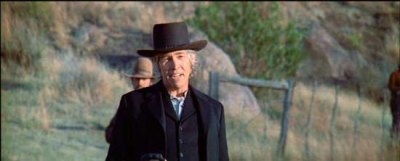
The typical sour male-female relations that show up in a lot of Peckinpah's work are aptly illustrated through Garrett's interactions with his wife and Billy's womanizing, though there is a sense of sadness and remorse to some of these scenes that might just give them a deeper meaning than what we see on the surface.
Coburn is great as the conflicted by honest man with the star. He's as solid as ever and plays his character well – he also looks the part of a tougher, older cowboy bringing an air of sadness and an uncomfortability with his position in the film which adds a sense of reality and conflict to the character of Pat Garrett that helps drive the movie. Kirstofferson gives a fine performance as well, and he proves to be not only charming but also intimidating when he needs to be. Billy the Kid was a killer and that part of his story is not glossed over here. Even if Kirstofferson looks a little older than a lot of us probably think Billy might have looked, he does a fine job with the material and some of the dialogue between these two men is as fine as anything in any Peckinpah movie and that includes The Wild Bunch. The weakest link in the acting department here is Bob Dylan who plays a supporting character named Alias. Dylan is too recognizable as himself to be even remotely believable and instead of saying 'hey look, it's Alias, what's his story?' you find yourself saying 'hey look, it's Bob Dylan… what's he doing here?' The music, written and performed by Dylan, also doesn't do the movie any favors.
Complains about Dylan aside, Pat Garrett And Billy The Kid does have an excellent supporting cast. Jason Robards, R. G. Armstrong, Katy Jurado, Jack Dodson, L. Q. Jones, Harry Dean Stanton, Slim Pickens and scads more show up in small supporting roles throughout the film, almost like they're saying goodbye to the two main characters as the story progresses. Peckinpah himself makes a cameo as Will the coffin maker, who utters a single line to Garrett during a fairly important juncture in the film.
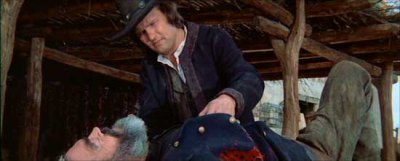
While some of the action scenes seem to be there simply to add more excitement to the movie rather than further the storyline along, they are impressive on a visual level. Some of the style and intensity associated with Peckinpah's shootouts is here and it does look very good. John Coquillon's cinematography is top notch and the movie looks very slick and very professional on a purely technical level.
Warner Brothers has seen fit to include note only the Turner Previews version of the movie that was reconstructed in 1988, but also a brand new 2005 cut of the film made to more closely resemble what scholars believe to be Peckinpah's personal idea of what the finished product should be. How do the two cuts of the film differ? Well, they essentially tell the same story but there are a few noticeable changes from one cut to the other, which result in the 2005 version of the movie coming out the winner. The scene where Poe talks Dub into giving up Billy The Kid's whereabouts has been completely excised from the new version which is a shame as now we have no real reason for how Poe finds him later in the movie, but other than that, the rest of the changes were improvements. A newly added scene shows Pat Garrett interacting with a hooker, played by Rutanya Alda, demonstrates the director's bleak view of male-female relations, and the ending has been altered considerably (to the point where it's the same effect, but told in a very different and much more interesting manner). Likewise, the film opens differently, with some cutting done between the notorious chicken shooting scenes and some more important footage that takes place later in the story, making for some very interesting foreshadowing of the tragedy to come. Other, minor scenes are trimmed a bit and the river raft sequence occurs earlier in this new version than it does in the Turner cut, but these changes don't have as much of an impact on the film as the aforementioned ones do. The 2005 version also works the Dylan songs used in the film into the storyline in a much more effective and sensible manner. All in all, the pacing is tighter and the movie noticeable more fluid in this new version than in the Turner Previews version on the other disc but thankfully both are here so should you disagree with this review, you've got your cut of the movie and I've got mine. The beauty of two disc sets…
Aside from the two cuts of the film that are presented in this two-disc set, there's also an alternate television cut and the original theatrical cut. Now, granted, neither of these were really all that close to Peckinpah's original vision for the finished product, however, having some of the material that made it into those version and not into the two versions presented here would have been nice, as would some sort of comparison between all four cuts of the movie.
Is Pat Garrett And Billy The Kid a masterpiece in the same way that The Wild Bunch is? No. It's a bit too disjointed in spots and a bit too meandering and the Dylan factor is too hard to ignore. However, at times, it does come very close to that level. The interplay between Garrett and Billy is very well done and Kirstofferson and Coburn are almost as good as Holden and Borgnine. The action scenes can't rival the finale of Peckinpah's most famous film but they can certainly hold their own and the movie just drips with atmosphere.
The DVD Video:
Each of the four movies benefits from being presented in its original aspect ratio, flagged properly for progressive scan hardware, and enhanced for anamorphic sets. The end results are very nice indeed and all four movies look very good to simply great, here's some more detail broken down by film:
The Wild Bunch:
The brand spanking new 2.40.1 anamorphic widescreen transfer that Warner has wrangled up for this new two disc special edition lays the last one to waste with a gattling gun. The first difference you'll notice is the color reproduction, which is much stronger, much more vibrant, and much more film like. The black levels are also strong and stable and the image is very clean and very clear. Both background and foreground detail are fantastic and print damage has been all but completely eliminated. There's a bit of grain present in a few scenes but honestly would you want it any other way? There aren't any problems with mpeg compression artifacts or edge enhancement and only the slightest traces of aliasing are noticeable at all during playback. Also worth noting is that while the first 1997 DVD release of the film was presented as a flipper, this new release is not, so thankfully you don't have to get up in the middle of the movie and change the disc.
The Ballad Of Cable Hogue:
The anamorphic 1.85.1 widescreen transfer for The Ballad Of Cable Hogue is very good but not on par with the transfer for The Wild Bunch. Some of the background detail looks a little less sharp than it might need to and there is some softness inherent in the image throughout as well as some moderate grain and the odd spec or two. Regardless, the movie still looks very good. Color reproduction is once again very strong and the black levels are good. No mpeg artifacts or edge enhancement to whine about here, and the skin tones look lifelike and natural. A very solid effort all around, even if it isn't quite perfect.
Ride The High Country:
The weakest of the four transfers in this set, the anamorphic 2.35.1 widescreen image is soft in spots and not quite as sharp as the other three films in the set. Again, it's not a bad transfer per se, but it is definitely not on par with the other movies in the set mainly because some of the fine detail in the background looks a little washed out. There aren't any digital transfer issues to complain about aside from some mild aliasing, and the color reproduction is once again strong, but the black levels look a little artificial in spots. Even with all of that said, the movie definitely looks better on DVD than it has on prior home video releases.
Pat Garrett And Billy The Kid:
The 2.35.1 anamorphic widescreen transfer on Pat Garrett And Billy The Kid is on par, if not slightly better, than the transfer for The Wild Bunch. The image is strong, clean and clear from start to finish with amazing color reproduction. In a direct comparison, the new 2005 special edition looks just a little bit better than the Turner Preview version of the film as the colors are a bit nicer and the image just a hair cleaner but both versions of the movie do look excellent on DVD. The blues in the sky contrasted against the dusty terrain looks just great and you can almost feel every grain of dust and dirt in the air as the movie plays out. Contrast is set perfectly, fine detail in both the foreground and the background of the image is amazingly strong and there's really not much at all to complain about in terms of the visuals on this release.
Sound:The new special edition DVD of The Wild Bunch features a brand new English language Dolby Digital 5.1 Surround Sound mix as well as a 2.0 Surround mix provided on French. Subtitles are available in English, French and Spanish and an English closed captioning option is also provided.
While purists will lament the fact that the original stereo sound mix is not present on this release, and it's odd that Warner Brothers opted not to include it, but the 5.1 track is very solid here. Thankfully the track doesn't bombard us with artificial sounding directional effects, and everything is well placed and makes sense. Dialogue is clean and clear and the sound effects and background music never over power the performers but still manage to come through the setup with plenty of punch. The grand finale of the film sounds excellent with plenty of gunshots and bullets whipping past you from a few different directions depending on where the action is coming from at the time. Aside from one or two very brief instances of mild background hiss, The Wild Bunch sounds damn near perfect on this release.
The Ballad Of Cable Hogue, Ride The High Country and both versions of Pat Garrett And Billy The Kid all feature their original Mono mixes in English as well an alternate Mono mix provided on French. Subtitles are available in English, French and Spanish and an English closed captioning option is also provided
All three films sound fine and while it would have been nice to have the same kind of quality surround mix that The Wild Bunch got for all of the films in the set, the mono tracks get the job done well enough. Dialogue is clean and clear and never buried beneath the music or effects work. There is the odd trace of hiss noticeable periodically but it's really minor and if you're not looking for it, odds are pretty good that you're not even going to pick up on it. The scores sound really nice for each of the three movies and there aren't any issues here – these are solid, through and through.
Extras:Not surprisingly, the supplements in the set are spread across the four films contained therein. Here's what you'll get and where you'll find it:
Ride The High Country:
Again, Nick Redman moderates a commentary with authors David Weddle, Garner Simmons and Paul Seydor. They give us some much appreciated background information on the key players in the production and do a fine job of explaining where Peckinpah was at personally during this period in his life and career. The four experts do a good job of mixing up the trivia and anecdotes with some interesting interpretation and critical analysis and while this track may only really appeal to those already in love with Sam Peckinpah's work, it is a very education and informative listen.
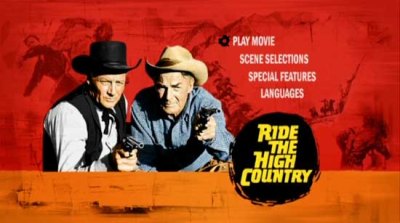
A Justified Life: Sam Peckinpah And The High Country is a keen documentary that examines Peckinpah's family history through some interviews with his sister, Fern Lea Peter. The documentary covers the family lineage, the fact that most of the men in the family held political positions at one point, and she talks about growing up in California with Sam. She talks about her their father influenced one of the characters in the film and speaks about her own relationship with her brother. Plenty of interesting archival photographs are included here that spice things up a bit and anyone interested in Peckinpah's personal life should enjoy this unique feature that does a very nice job of filling in some of the background information on the director through someone who knew him very well.
Once again, rounding out the extra features on this release are trailers for the four films in the set and the Warner Brothers James Dean Collection.
The Wild Bunch:
First up on this two disc set? Nick Redman moderates a commentary with authors David Weddle, Garner Simmons and Paul Seydor. Anyone who has heard the commentary tracks provided by these four gentlemen on previous Peckinpah DVDs such as MGM's Bring Me The Head Of Alfredo Garcia or MGM's release of Junior Bonner knows that these four guys definitely know their stuff and although they all share a mutual admiration of the director and his work, they're differences in critical opinion can often make for an interesting and engaging discussion – this is the case with the commentary on this DVD. The four participants are so completely into the film and so undeniably enthusiastic about The Wild Bunch that they get right into their work and as such, this is the best commentary of the bunch in this set. The facts come flying fast and furious as they cover the history of the film, the impact that it had on its theatrical release, trivia relating to the cast and the crew, and some of the issues that Peckinpah had in getting the film made. The cover censorship issues, where Sam was at in her personal life while the movie was being made, and how certain aspects of it relate to his life. There's also no shortage of critical analysis and personal interpretation in here, making for a very well balanced and active discussion of what many consider to be the finest American western film ever made.
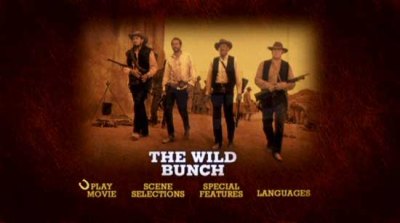
Up next is the thirty-three minute documentary, The Wild Bunch: A Portrait In Montage which uses a wealth of clips from the feature as well as some fantastic on set 16mm behind the scenes footage from Mexico to paint a picture of life on the set. Much of the text from the book of the same name by Garner Simmons is used in the narration to provide a whole lot of detail and insight into what it might have been like working on the production. Anyone who was still alive when this was made was called in to read their own sections for the narration, with some interesting substitutes showing up for those who have passed on, such as Ed Harris reading for Peckinpah. As good as this material is, however, the presentation is pretty bad in terms of video quality. This featurette appeared on the first DVD and it actually looks better there than it does on this new edition which is riddled with defects for some reason.
Sam Peckinpah's West: Legacy Of A Hollywood Renegade is up next, which originally appeared on the Starz/Encore cable channels in 2004. Narrated by Kris Kirstofferson, this retrospective takes a look at pretty much all of Peckinpah's western output from the early days in television working on The Rifleman with Chuck Connors, through The Wild Bunch and the other movies contained in this set – they even go all the way out to Alfredo Garcia and make some interesting comparisons there. Interviews with modern Hollywood alumni such as Benecio Del Toro and Roger Ebert provide a well-rounded overview of his career and his impact without being so ignorant as to sweep his drug and alcohol problems under the rug. This documentary does a very good job of introducing the viewer to Peckinpah's body of work, explaining the dominant themes that can be found throughout, and contrasting the characters and events in his movies to the characters and events in his own life.
The third and final featurette on this two disc set is a twenty-three minute except from Nick Redman's documentary, A Simple Adventure Story: Sam Peckinpah, Mexico, And The Wild Bunch. In this clip we ride along with the biographers as they visit the modern day equivalent of the Mexican locations where The Wild Bunch was filmed. Peckinpah's daughter shows up for a bit and it's pretty interesting to see the locations today, though really this isn't much more than a preview for the entire documentary – here's hoping we see it sooner rather than later.
Warner Brothers has also supplied a selection of outtakes that, when totaled, run for roughly eight minutes. Covering four scenes in total (River, Desert, Train Robbery and Bridge), this excised material sees the light of day on home video for the first time on this release. Some of this material is more or less blooper footage, others look like alternate angle shots of material we've seen before. The Bridge scene in particular is interesting, as the horses don't exactly cooperate with the performers here.
Rounding out the extra features on this release are trailers for the four films in the boxed set and for the Warner Brothers James Dean Collection.
The Ballad Of Cable Hogue:
As with The Wild Bunch DVD, here Nick Redman moderates a commentary with authors David Weddle, Garner Simmons and Paul Seydor. This is a very active track with a fine sense of friendship and humor running throughout. The four biographers throw ideas back and fourth and vary slightly on their personal interpretations of certain scenes and moments in the movie, but this all makes for an interesting discussion of one of the stranger films from Peckinpah's filmography.
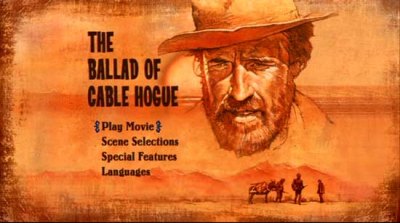
A featurette entitled The Ladiest Damn'd Lady: An Afternoon With Stella Stevens clocks in at just under twenty-seven minutes in length and gives the actress who played Hildy her chance to wax nostalgic about her work on the film and her relationship with Peckinpah. She gives us some interesting background information on her earlier film work and how she came on board for Hogue before delving into her less than flattering views on Peckinpah himself. Stevens does manage to give us some interesting and through provoking comments on her character and explains her take on the movie as well.
Rounding out the extra features on this release are trailers for the four films in the set and the Warner Brothers James Dean Collection.
Pat Garrett And Billy The Kid:
If you guess that on this release Nick Redman moderates a commentary with authors David Weddle, Garner Simmons and Paul Seydor, you'd be right, although the commentary is only available for the new 2005 version of the film. Those who enjoy knowing the differences between various versions of one particular film will enjoy this dissection of the material here as the four scholars explain how they movie was re-cut for this release to replicate as closely as possible the version of the film that Sam Peckinpah wanted to make according to the dire
In addition to the commentary track, there's also a nice featurette on here entitled Deconstructing Pat And Billy that examines the convoluted history of the film and its director by way of some interviews with Katy Haber who was both Peckinpah's personal assistant and girlfriend for a while. She gives us some very interesting insight into where his mind was at while this film was underway. Paul Seydor shows up to tell us about the trials and tribulations that Peckinpah went through while trying to get the movie into theaters. He details how power mad MGM head honcho James Aubrey basically had his own cut of the film made unbeknownst to Sam as Peckinpah himself was editing his own cut of the movie, without any intentions of ever letting the director's version of the film see the light of day in the first place.
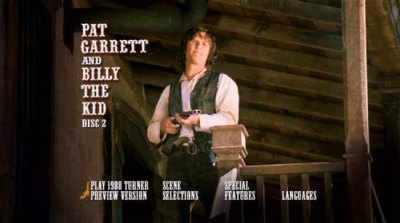
A second featurette entitled One Foot In The Grave: Remembering Sam Peckinpah And Other Things incorporates some great interview footage with Kris Kirstofferson who gives us his take on why Peckinpah was as self destructive as he was and how his behavior made sense given his then current state of alcoholism and drug abuse. Kris has got a whack of great stories to tell about his work with Sam (he also appears as a rapist in Bring Me The Head Of Alfredo Garcia and plays the lead in Convoy) and he was one of the few actors who got to know the man off the set as well as on. Donnie Fritts shows up in here as well to give us his take on things – he too appeared in this film and in Garcia and Convoy and while he didn't spend as much time with the director as Kristofferson did, he's still got some interesting stories to tell about the man.
Kris Kirstofferson and Donnie Fritts get in front of the camera for Nick Redman and perform two songs that relate to the director exclusively for this DVD, entitled One For The Money and Sam's Song respectively. It's a nice little homage to the late director and it's fitting that they're included in this set.
Once again, rounding out the extra features on this release are trailers for the four films in the boxed set and for the Warner Brothers James Dean Collection. A booklet detailing the differences between the two cuts of the film presented on this set and explaining why the theatrical cut is not included would have been nice, but as it stands the commentary and the documentaries do a fine job of covering most of that ground.
Final Thoughts:Sam Peckinpah fans have been waiting with baited breath for this one and thankfully, the fine folks over at Warner Brothers have not let us down. Minor issues aside, there's really not much else to complain about on this release as they really have gone the extra mile and put a lot of blood, sweat and tears into making this the finest presentation of these films as is realistically possible.
All four movies look and sound very good and the wealth of extra features on this release, while not quite definitive, are informative, interesting, and very appropriate. Given all of that, it's not surprising to hear that Sam Peckinpah – The Legendary Westerns Collection comes highly recommended.
Ian lives in NYC with his wife where he writes for DVD Talk, runs Rock! Shock! Pop!. He likes NYC a lot, even if it is expensive and loud.
|
| Popular Reviews |
| Sponsored Links |
|
|
| Sponsored Links |
|
|
| Release List | Reviews | Shop | Newsletter | Forum | DVD Giveaways | Blu-Ray | Advertise |
|
Copyright 2024 DVDTalk.com All Rights Reserved. Legal Info, Privacy Policy, Terms of Use,
Manage Preferences,
Your Privacy Choices | |||||||













